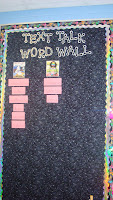
FAIR, I know the word conjures up memories of ferris wheels, pony rides, cheesy games, cotton candy, and funnel cake, but all over the state of Florida, Reading teachers have learned that FAIR, in the educational realm, actually stands for Florida Assessments for Instruction in Reading. A Reading inventory developed by the Florida Center for Reading Research given statewide to diagnose and prescribe instruction.
As you can imagine, with any new assessment comes training for the staff and first time implementation glitches. As mentioned in my last post, this training occurred in our last Early Release session. So, the next step after training was implementation. To support the teachers in Second Grade, I offered my services all week. On Mo

nday morning, I watched
dayle timmons model a FAIR assessment by administering it to a student while a small group of us watched. Then, we debriefed to make sure we understood the process.
Next, I dove in by modeling the FAIR with a student while several teachers watched me and then I watched as they administered a few. In K-2, this is a one-on-one test that also requires the states PMRN site to be up and running properly. In 3rd-5th, it is a whole group assessment administered in a computer lab. So, as our technology coach assisted in the tech lab, I went classroom to classroom to support classroom teachers' assessment work.
To our surprise, the week got off to a good start with relatively few computer glitches, and we began to feel confident that perhaps this FAIR assessment was going to work. Then, the major problems began Thursday morning. When we tried to log in, the PMRN site simply didn't work.
We waited about an hour and the issue was resolved. But, on Friday, not one student was tested, because the site was down all day. The testing window is a month and I'm sure our classroom teachers will be able to complete the assessments, if the computer issues on the PMRN site get resolved. If they don't, I'll be disappointed, because as I look at the reports, I think the teachers will get valuable information for planning instruction.
My advice, for teachers, at this point would be, to have a back up plan. Teachers will have to go in to each day with a plan to administer FAIR, but if it doesn't work, they'll need a back up plan. I know this is frustrating for teachers, but I also know they don't want to waste any classroom instructional time. In addition, I would caution teachers throughout the state that each student's test looks somewhat different because it follows a different path based on the student's needs. I administered three assessments in a row on Wednesday in about 25 minutes, but the next child took me 35 minutes, and when the computer kicked me off, I still wasn't done. I'm hoping that when I log back in on Monday, the student's data will be saved. However, some of my colleagues have logged back in to find vanished data. I know that there will be frustrations including time and computer issues, but I'm hoping that with firmly established rituals and routines, and tons of patience on the part of teachers, they will see the value in administering an assessment that gives them accurate information to prescribe instruction. I'm also hoping educators doing the computer lab scheduling don't simply give up, because they have to continually rebook students into a lab.
My advice, for coaches, at this point would be, dive in and help. Going classroom to classroom and assisting teachers has taught me a lot about the assessment itself, and about the problems teachers may encounter. It also has given me information that may assist in offering support to struggling students. I hope that the teachers I've assisted have felt better having someone standing beside them to get them started. Do I have tons of other things to get done? Absolutely. But, none as valuable as offering classroom support to teachers in their time of need.
 I always find pleasure in serving as a judge at the annual 5th Grade Spelling Bee, but I can honestly say, I am thrilled not to have serve as the announcer! Each year, Mrs. Phillips, does an extraordinary job in her role as the announcer as she calls each participant forward, carefully pronounces each word, and gives definitions an
I always find pleasure in serving as a judge at the annual 5th Grade Spelling Bee, but I can honestly say, I am thrilled not to have serve as the announcer! Each year, Mrs. Phillips, does an extraordinary job in her role as the announcer as she calls each participant forward, carefully pronounces each word, and gives definitions an d sentences when asked. I don't know if she feels like she's in a pressure cooker, but I know I feel it for her!
d sentences when asked. I don't know if she feels like she's in a pressure cooker, but I know I feel it for her!














































